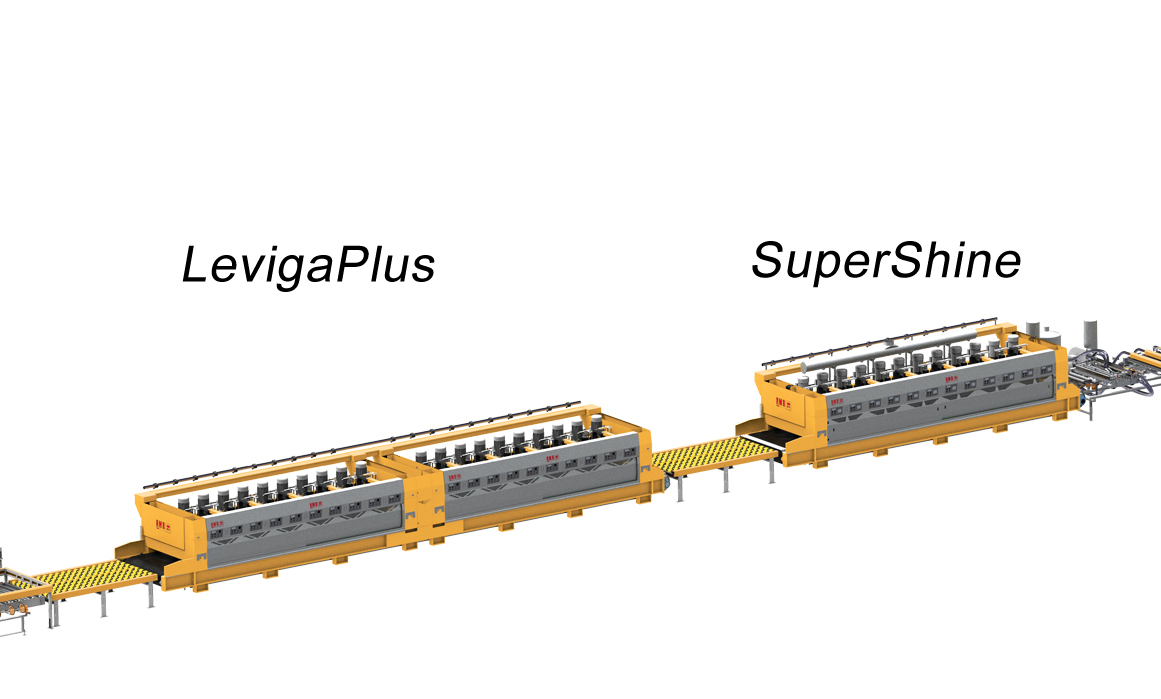written by Claudio Avanzi
DOWNLOAD THE ARTICLE (ITA/ENG) AND THE COORDINATED IMAGES
The tile technologies and production ceramic sector is constantly evolving: the sizes and processes that follow it have changed, and the development of large slabs has experienced a high level of popularity, with the consequent adaptation of many applied technologies.
The process dedicated to the finishing of ceramic surfaces is one of the main sectors involved in this new dynamic: whether it is glazed porcelain stoneware, solid stoneware full-body or double loading, each type of surface welcomes lapping, thanks to its versatility and multiplicity of tools available.
In fact, for glazed surfaces we will proceed directly with polishing tool grain; for technical porcelain, on the other hand, lapping already includes the grinding tool grain.
The innovative aspect involves the step after lapping, or the super-polishing treatment.
BMR has exploited its know-how and its proven experience in the ceramic end-of-line sector to develop SuperShine: this is a machine dedicated to a treatment very similar to that of the lapping machine, but heavier, and equipped with dry technology which allows it to be defined in all respects the first dry super polisher.
It is a very important evolution for the sector, which BMR has been able to promote in an exclusive and pioneering way thanks to the continuous investments in research & development that have always placed the Scandiano company at the forefront in the technological sector.
SuperShine is a high-tech machine that through thermomechanical processing is capable of increasing the degree of Gloss coming from lapping by 20 points and more.
SuperShine is based on the use of 7 Æ 580 mm satellite heads with 6 Æ160 mm tools, driven by 15 kW motors, which allow the machine to significantly increase its productivity, arriving and exceeding belt speeds of 10 m/minute.
Each head applies a quantity of micro-abrasive product and natural silica in fluid suspension, programmed and dosed by the machine’s control panel and pressed by the force and weight of these heads.
During the super-polishing phase, the fluid and the micro-abrasive conveyed by it are brushed onto the surface of the tile or slab under pressure: the pressure allows a high penetration into the porosity and the micro-grooves which, in turn, are blocked and reduced by brushing, which reduces ridges.
Two other output heads are then dedicated to washing the surfaces: their super-polishing action of the micro-grooves in depth guarantees continuity in the quality of the finished product.
The SuperShine super-polishing therefore makes the ceramic surface more resistant to trampled dirt and staining, thanks also to the smoothing process that makes the surface uniform.
There is, in fact, a close relationship between the Glosses achieved and the roughness of the material (Ra), represented by the average value between peaks and valleys of the micro-grooves (expressed in µ = thousandths of a mm).
Although roughness is difficult to perceive by the human touch, its value is nevertheless important for the treatment and therefore for the quality of the finished product.
Generally, in fact, a lapped product reaches the super-polishing phase with 55/60 Gloss at Ra 0.060 mm and leaves the treatment at 95/100 Gloss with an average roughness Ra 0.020 mm. This end value establishes a good resistance to the tile’s dirt and stain resistance. If instead the end value remains Ra 0.060 mm, it means that the treated product had too high a roughness which could invalidate the effectiveness of the treatment.
It is therefore evident that the lapped surface has deep porosities and micro-grooves that can compromise the cleanability of the surface; the mechanical action of super-polishing therefore brings a clear improvement since, by reducing the ridges of the grooves, it allows the occlusion of the pore to be more incisive, thus defining the tile’s high resistance value to dirt.
Precisely because of all the technical and technological characteristics of this process, BMR tends to consider the technological lapping process as the ensemble of the wet lapping and dry super-polishing phases, that can be obtained with the combination of LevigaPlus and SuperShine.
This is a great advantage for users who can trace the manufacturing process back to a single very complete and flexible machine, thanks to the availability of functions, accessories and mechatronics elements that allow the standards to be followed as well as evolving the work cycles. The polishing process could thus be very simply adapted to each type of ceramic surface by the operator: the management of the parameters of use of BMR technologies are already open and dedicated to what is available on the market in terms of tools and super protective polishing products, ensuring the best results with maximum optimization of resources.



